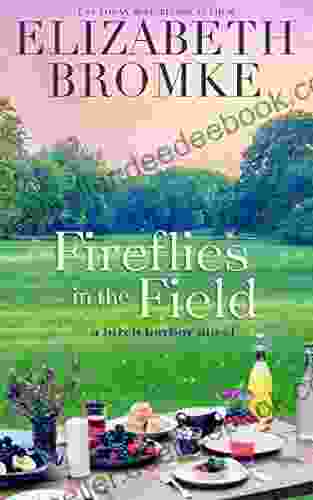Fireflies In The Field: An Enchanting Nocturnal Wonder

As the sun dips below the horizon, a magical transformation unfolds in the fields. Diminutive creatures, adorned with a captivating glow, emerge from concealment, illuminating the night with their ethereal dance. These are the fireflies, nature's enigmatic performers that have captivated humans for centuries.
Fireflies, also known as lightning bugs, belong to the order Coleoptera, the largest order of insects. Their distinctive bioluminescence makes them one of the most recognized and cherished insects in the world. In this comprehensive guide, we delve into the enchanting world of fireflies in the field, exploring different species, their habitats, and the factors that influence their presence.
4.5 out of 5
| Language | : | English |
| File size | : | 3349 KB |
| Text-to-Speech | : | Enabled |
| Screen Reader | : | Supported |
| Enhanced typesetting | : | Enabled |
| X-Ray | : | Enabled |
| Word Wise | : | Enabled |
| Print length | : | 288 pages |
| Lending | : | Enabled |
| Item Weight | : | 3.17 pounds |
| Dimensions | : | 8.86 x 1.1 x 10.24 inches |
Firefly Species and Diversity
The family Lampyridae encompasses a dazzling array of firefly species, each with unique characteristics. In North America alone, there are over 200 species of fireflies, each emitting a distinct pattern and intensity of light.
One of the most widespread species is the Eastern firefly (Photinus pyralis). This firefly is known for its synchronized flashing displays during courtship, where males emit short, bright flashes to attract females. The female responds with a longer, dimmer flash, signaling her interest.
Another notable species is the Big Dipper firefly (Photuris pennsylvanica). This firefly is larger than most species and exhibits a unique mating strategy known as mimicry. Female Photuris fireflies mimic the flash patterns of other firefly species to lure unsuspecting males for prey.
Habitat and Distribution
Fireflies are primarily found in warm, humid environments, such as forests, meadows, wetlands, and gardens. They are most active during the summer months, although some species may also be seen in spring and autumn.
The distribution of fireflies varies depending on the species. Some species, like the Eastern firefly, are widely distributed across North America. Others, such as the Great Smoky Mountains firefly (Photinus macdermotti),are endemic to specific geographic regions.
Factors Influencing Firefly Presence
The presence of fireflies in a particular area is influenced by several factors, including habitat quality, weather conditions, and light pollution.
Fireflies prefer undisturbed habitats with dense vegetation and access to water. These habitats provide shelter, food, and moisture, which are essential for the fireflies' survival and reproduction.
Weather conditions also play a role in firefly activity. Warm, humid nights are ideal for fireflies, as these conditions favor their flight and mating activities. Rain or strong winds can hinder their flight and reduce their visibility.
Light pollution, caused by artificial lights, can have a detrimental impact on fireflies. Artificial lights can disrupt their natural light patterns, making it difficult for them to communicate and find mates. This can lead to a decline in firefly populations in urban and suburban areas.
The Science of Bioluminescence
The captivating glow of fireflies is a result of a complex biochemical process called bioluminescence. This process involves the oxidation of a molecule called luciferin in the presence of the enzyme luciferase, releasing energy in the form of light.
Fireflies have specialized light organs located in their abdomen. These organs contain luciferin, luciferase, and other molecules that facilitate the light production process. By controlling the flow of oxygen to the light organs, fireflies can regulate the intensity and duration of their light emissions.
The light emitted by fireflies serves several purposes. It is primarily used for communication during courtship and mate attraction. Different species of fireflies have evolved unique flash patterns that allow them to distinguish between potential mates and other species.
In addition to courtship, some fireflies also use their light for defense. By emitting bright flashes, they can startle or deter potential predators.
Ecological Significance
Fireflies play a vital role in the ecosystem. They are a food source for various animals, including birds, bats, and spiders. Their presence in an ecosystem indicates a healthy and diverse environment.
Fireflies also contribute to the pollination of plants. While they are not as efficient pollinators as bees or butterflies, they can still transfer pollen between flowers during their nocturnal flights.
Conservation and Protection
The enchanting world of fireflies is facing threats from habitat loss, light pollution, and pesticide use. These factors have led to a decline in firefly populations in many areas.
To help conserve fireflies, it is important to protect their habitats, reduce light pollution, and minimize the use of pesticides. Planting native plants that attract fireflies, such as firefly lilies and daisies, can also help increase their presence in an area.
By taking these steps, we can help ensure that future generations can continue to marvel at the enchanting glow of fireflies in the field.
Fireflies are a captivating natural phenomenon that brings wonder and joy to those who witness their enchanting nocturnal display. Their unique bioluminescence, diverse species, and ecological significance make them an integral part of our natural world.
As we continue to learn more about these fascinating creatures, it is imperative that we work together to protect their habitats and ensure their presence for future generations. By embracing the beauty of fireflies and fostering their well-being, we not only preserve a remarkable aspect of nature but also enrich our own lives with their magical glow.
4.5 out of 5
| Language | : | English |
| File size | : | 3349 KB |
| Text-to-Speech | : | Enabled |
| Screen Reader | : | Supported |
| Enhanced typesetting | : | Enabled |
| X-Ray | : | Enabled |
| Word Wise | : | Enabled |
| Print length | : | 288 pages |
| Lending | : | Enabled |
| Item Weight | : | 3.17 pounds |
| Dimensions | : | 8.86 x 1.1 x 10.24 inches |
Do you want to contribute by writing guest posts on this blog?
Please contact us and send us a resume of previous articles that you have written.
 Page
Page Genre
Genre Reader
Reader Library
Library Paperback
Paperback Newspaper
Newspaper Paragraph
Paragraph Bookmark
Bookmark Shelf
Shelf Glossary
Glossary Foreword
Foreword Synopsis
Synopsis Footnote
Footnote Scroll
Scroll Codex
Codex Tome
Tome Library card
Library card Narrative
Narrative Biography
Biography Autobiography
Autobiography Dictionary
Dictionary Thesaurus
Thesaurus Narrator
Narrator Resolution
Resolution Stacks
Stacks Archives
Archives Periodicals
Periodicals Research
Research Lending
Lending Academic
Academic Journals
Journals Reading Room
Reading Room Rare Books
Rare Books Special Collections
Special Collections Literacy
Literacy Study Group
Study Group Thesis
Thesis Dissertation
Dissertation Reading List
Reading List Textbooks
Textbooks Tshilidzi Marwala
Tshilidzi Marwala Collin Yarbrough
Collin Yarbrough Fran Pickering
Fran Pickering Mervyn Cooke
Mervyn Cooke Geoff Harkness
Geoff Harkness Dr Morgan L Jones
Dr Morgan L Jones Jorge Lozano
Jorge Lozano Robin Gardiner
Robin Gardiner David Barnett
David Barnett Brian Gruber
Brian Gruber Marc Martin
Marc Martin Philip Wilkinson
Philip Wilkinson Kat Savage
Kat Savage N A M Rodger
N A M Rodger Kerry L Fay
Kerry L Fay Jennifer Adams
Jennifer Adams Peter J Gosling
Peter J Gosling Brett Callwood
Brett Callwood Peter Edwards
Peter Edwards Scott C Docherty
Scott C Docherty
Light bulbAdvertise smarter! Our strategic ad space ensures maximum exposure. Reserve your spot today!

 Oscar WildeUnveiling the Harmonies of Piano Vocal Chords: A Journey Through the Broadway...
Oscar WildeUnveiling the Harmonies of Piano Vocal Chords: A Journey Through the Broadway...
 Brody PowellThe Real Easy Ear Training: A Comprehensive Guide to Developing Your Musical...
Brody PowellThe Real Easy Ear Training: A Comprehensive Guide to Developing Your Musical... Eli BrooksFollow ·19.3k
Eli BrooksFollow ·19.3k Jimmy ButlerFollow ·12.6k
Jimmy ButlerFollow ·12.6k Easton PowellFollow ·17.9k
Easton PowellFollow ·17.9k J.R.R. TolkienFollow ·3.8k
J.R.R. TolkienFollow ·3.8k Lawrence BellFollow ·2.1k
Lawrence BellFollow ·2.1k James HayesFollow ·15.2k
James HayesFollow ·15.2k Billy FosterFollow ·10.7k
Billy FosterFollow ·10.7k Leon FosterFollow ·8.1k
Leon FosterFollow ·8.1k

 Brian Bell
Brian BellClassic Festival Solos Bassoon Volume Piano...
The Classic Festival Solos Bassoon Volume...

 Aubrey Blair
Aubrey BlairUnveiling the Courage: Insurgent Women Female Combatants...
In the face of armed...

 Jan Mitchell
Jan MitchellFor The Liberty Of Texas: The Lone Star State's Fight for...
The Republic of Texas was a sovereign state...

 Edgar Allan Poe
Edgar Allan PoeVisible, Explainable, Trustworthy, and Transparent...
What is VET2...
4.5 out of 5
| Language | : | English |
| File size | : | 3349 KB |
| Text-to-Speech | : | Enabled |
| Screen Reader | : | Supported |
| Enhanced typesetting | : | Enabled |
| X-Ray | : | Enabled |
| Word Wise | : | Enabled |
| Print length | : | 288 pages |
| Lending | : | Enabled |
| Item Weight | : | 3.17 pounds |
| Dimensions | : | 8.86 x 1.1 x 10.24 inches |












